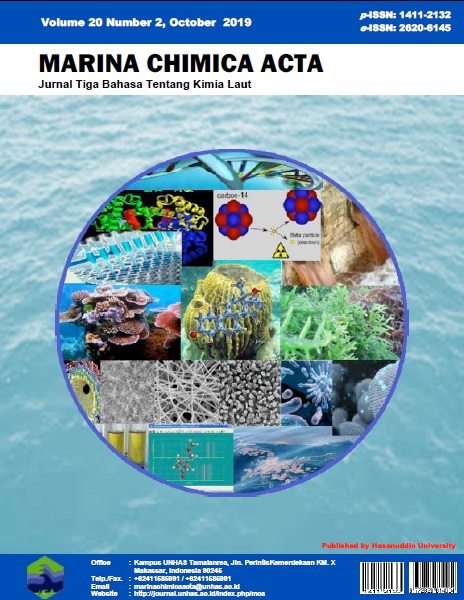PLANKTON ABUNDANCE BETWEEN DRY AND RAINY SEASON IN TALLO FRESHWATER AND PANGKEP RIVER
Abstract
Plankton abundance is influenced by seasons, sea surface currents (SSC), nutrients and surface temperature (SST). Is a marine organism has a function to stabilize the surface temperature of the earth by regulating the concentration of Dimetyl sulfide (DMS) due to exposure to direct sunlight. There is the ability of the ocean to regulate warming and to regulate the distribution of water vapor in the atmosphere which is controlled by sea surface temperature. Sampling using the transeck system in September and January represents the rainy season and the dry season which is closest to the Tallo river estuary and the Pangkep river estuary represents the estuary region, towards the coast of the spermonde (Litoral) islands and far from the coast (offshore) from freshwater sources, but the relationship of nutrient entry into estuary areas by sea surface currents (SSC) is still poorly known. The dominant aspect of phytoplankton is determined by the amount of nutrients flowing (runoff) from land to estuary to spermonde watersReferences
L. W. Harding Jr. et al., ‘Climate effects on phytoplankton floral composition in Chesapeake Bay’, Estuarine, Coastal and Shelf Science, vol. 162, pp. 53–68, Sep. 2015.
T. Rixen et al., ‘Impact of monsoon-driven surface ocean processes on a coral off Port Blair on the Andaman Islands and their link to North Atlantic climate variations’, Global and Planetary Change, vol. 75, no. 1–2, pp. 1–13, Jan. 2011.
J. M. Wallace and P. V. Hobbs, ‘Climate Dynamics’, in Atmospheric Science (Second Edition), San Diego: Academic Press, 2006, pp. 419–465.
J. Liu, J. Chen, X. Zhang, Y. Li, Z. Rao, and F. Chen, ‘Holocene East Asian summer monsoon records in northern China and their inconsistency with Chinese stalagmite δ18O records’, Earth-Science Reviews, vol. 148, pp. 194–208, Sep. 2015.
K. Pedoja et al., ‘On the long-lasting sequences of coral reef terraces from SE Sulawesi (Indonesia): Distribution, formation, and global significance’, Quaternary Science Reviews, vol. 188, pp. 37–57, May 2018.
A. Baum, T. Rixen, and J. Samiaji, ‘Relevance of peat draining rivers in central Sumatra for the riverine input of dissolved organic carbon into the ocean’, Estuarine, Coastal and Shelf Science, vol. 73, no. 3–4, pp. 563–570, Jul. 2007.
F. A. Schott and J. P. McCreary Jr., ‘The monsoon circulation of the Indian Ocean’, Progress in Oceanography, vol. 51, no. 1, pp. 1–123, 2001.
W. Renema and S. R. Troelstra, ‘Larger foraminifera distribution on a mesotrophic carbonate shelf in SW Sulawesi (Indonesia)’, Palaeogeography, Palaeoclimatology, Palaeoecology, vol. 175, no. 1, pp. 125–146, 2001.
Abd. Rasyid J., Nurjannah N, A. Iqbal B., and Muh. Hatta, ‘Makassar Water Oceanography Character which connected with Fishing Potential Area of Small Pelagic Fish on East Season’, Jurnal Ipteks psp, vol. 1, no. 1, pp. 69–80, Mar. 2014.
Robert Vet, ‘A global assessment of precipitation chemistry and deposition of sulfur, nitrogen, sea salt, base cations, organic acids, acidity and pH, and phosphorus’, Atmospheric Environment, vol. 93, 2014.
R. R. Hood et al., ‘Pelagic functional group modeling: Progress, challenges and prospects’, Deep Sea Research Part II: Topical Studies in Oceanography, vol. 53, no. 5, pp. 459–512, 2006.
R. J. Charlson, T. L. Anderson, and R. E. McDuff, ‘13 - The Sulfur Cycle’, in Earth System Science, vol. 72, M. C. Jacobson, R. J. Charlson, H. Rodhe, and G. H. Orians, Eds. Academic Press, 2000, pp. 343–359.
W. G. Sunda and K. W. Shertzer, ‘Positive feedbacks between bottom-up and top-down controls promote the formation and toxicity of ecosystem disruptive algal blooms: A modeling study’, Harmful Algae, vol. 39, pp. 342–356, 2014.
O. W. Wingenter, S. M. Elliot, and D. R. Blake, ‘New Directions: Enhancing the natural sulfur cycle to slow global warming’, Atmospheric Environment, vol. 41, no. 34, pp. 7373–7375, 2007.
A. Robinson, ‘Review: The Vanishing Face of Gaia by James Lovelock’, New Scientist, vol. 201, no. 2697, p. 46, Feb. 2009.
C. A. Marwood, R. E. H. Smith, M. N. Charlton, K. R. Solomon, and B. M. Greenberg, ‘Photoinduced Toxicity to Lake Erie Phytoplankton Assemblages from Intact and Photomodified Polycyclic Aromatic Hydrocarbons’, Journal of Great Lakes Research, vol. 29, no. 4, pp. 558–565, 2003.
Z. Ü. Yümün and M. Önce, ‘Monitoring heavy metal pollution in foraminifera from the Gulf of Edremit (northeastern Aegean Sea) between Izmir, Balıkesir and Çanakkale (Turkey)’, Journal of African Earth Sciences, vol. 130, pp. 110–124, 2017.
W. Wardencki, ‘Sulfur Compounds: Gas Chromatography☆’, in Reference Module in Chemistry, Molecular Sciences and Chemical Engineering, Elsevier, 2014.
A. J. Richardson, ‘Plankton and Climate’, in Encyclopedia of Ocean Sciences (Second Edition), J. H. Steele, Ed. Oxford: Academic Press, 2009, pp. 455–464.
S. Ribeiro, T. Berge, N. Lundholm, and M. Ellegaard, ‘Hundred Years of Environmental Change and Phytoplankton Ecophysiological Variability Archived in Coastal Sediments: e61184’, PLoS One, vol. 8, no. 4, Apr. 2013.

